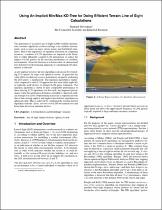 ResearchSpace
ResearchSpace
Using an implicit min/max KD-Tree for doing efficient terrain line of sight calculations
JavaScript is disabled for your browser. Some features of this site may not work without it.
- ResearchSpace
- →
- Research Publications/Outputs
- →
- Conference Publications
- →
- View Item
| dc.contributor.author |
Duvenhage, B

|
|
| dc.date.accessioned | 2009-02-19T13:57:27Z | |
| dc.date.available | 2009-02-19T13:57:27Z | |
| dc.date.issued | 2009-02 | |
| dc.identifier.citation | Duvenhage, B. 2009. Using an implicit min/max KD-Tree for doing efficient terrain line of sight calculations. 6th International Conference on Virtual Reality, Computer Graphics, Visualisation and Interaction in Africa. Centurion, South Africa, 4 - 6 February 2009, pp 10 | en |
| dc.identifier.isbn | 978-1-60558-428-7 | |
| dc.identifier.uri | http://hdl.handle.net/10204/3041 | |
| dc.description | Copyright: 2004-2008 African Graphics Association | en |
| dc.description.abstract | The generation of accurate Line of Sight (LOS) visibility information consumes significant resources in large scale synthetic environments such as many-on-many serious games and battlefield simulators. Due to the importance of optimum utilisation of computing resources, a number of LOS algorithms are reported in the literature to either efficiently compute LOS information or reduce the impact of LOS queries on the run-time performance of synthetic environments. From the literature it is known that a k-dimensional tree (kd-tree) based raytracing approach, to calculating LOS information, is efficient. A new implicit min/max kd-tree algorithm is discussed for evaluating LOS queries on large scale spherical terrain. In particular the value of low resolution boundary information, in quickly evaluating the LOS query, is emphasised. The min/max algorithm is empirically compared to other LOS approaches that have either implicitly or explicitly used kd-trees to optimise LOS query evaluation. The min/max algorithm is shown to have comparable performance to these existing LOS algorithms for flat earth, but improved performance when the application domain is extended to spherical earth. An average of a factor 3.0 performance increase is experienced over that of the existing implicit and explicit max kd-tree algorithms on spherical earth. This is achieved by combining the existing kd-tree algorithm with the classic smooth-earth LOS obscuration test and from there the min in min/max kd-tree | en |
| dc.description.sponsorship | This paper has been published on DVD under ACM Copyright | en |
| dc.language.iso | en | en |
| dc.publisher | African Graphics Association | en |
| dc.subject | Line of sight | en |
| dc.subject | Implicit kd-tree | en |
| dc.subject | Spherical earth | en |
| dc.title | Using an implicit min/max KD-Tree for doing efficient terrain line of sight calculations | en |
| dc.type | Conference Presentation | en |
| dc.identifier.apacitation | Duvenhage, B. (2009). Using an implicit min/max KD-Tree for doing efficient terrain line of sight calculations. African Graphics Association. http://hdl.handle.net/10204/3041 | en_ZA |
| dc.identifier.chicagocitation | Duvenhage, B. "Using an implicit min/max KD-Tree for doing efficient terrain line of sight calculations." (2009): http://hdl.handle.net/10204/3041 | en_ZA |
| dc.identifier.vancouvercitation | Duvenhage B, Using an implicit min/max KD-Tree for doing efficient terrain line of sight calculations; African Graphics Association; 2009. http://hdl.handle.net/10204/3041 . | en_ZA |
| dc.identifier.ris | TY - Conference Presentation AU - Duvenhage, B AB - The generation of accurate Line of Sight (LOS) visibility information consumes significant resources in large scale synthetic environments such as many-on-many serious games and battlefield simulators. Due to the importance of optimum utilisation of computing resources, a number of LOS algorithms are reported in the literature to either efficiently compute LOS information or reduce the impact of LOS queries on the run-time performance of synthetic environments. From the literature it is known that a k-dimensional tree (kd-tree) based raytracing approach, to calculating LOS information, is efficient. A new implicit min/max kd-tree algorithm is discussed for evaluating LOS queries on large scale spherical terrain. In particular the value of low resolution boundary information, in quickly evaluating the LOS query, is emphasised. The min/max algorithm is empirically compared to other LOS approaches that have either implicitly or explicitly used kd-trees to optimise LOS query evaluation. The min/max algorithm is shown to have comparable performance to these existing LOS algorithms for flat earth, but improved performance when the application domain is extended to spherical earth. An average of a factor 3.0 performance increase is experienced over that of the existing implicit and explicit max kd-tree algorithms on spherical earth. This is achieved by combining the existing kd-tree algorithm with the classic smooth-earth LOS obscuration test and from there the min in min/max kd-tree DA - 2009-02 DB - ResearchSpace DP - CSIR KW - Line of sight KW - Implicit kd-tree KW - Spherical earth LK - https://researchspace.csir.co.za PY - 2009 SM - 978-1-60558-428-7 T1 - Using an implicit min/max KD-Tree for doing efficient terrain line of sight calculations TI - Using an implicit min/max KD-Tree for doing efficient terrain line of sight calculations UR - http://hdl.handle.net/10204/3041 ER - | en_ZA |





